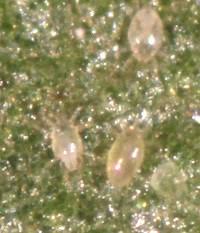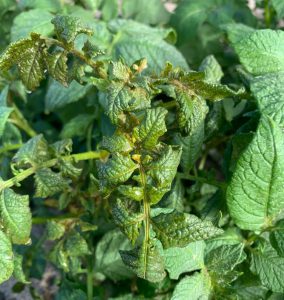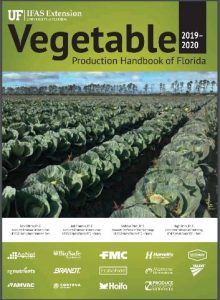Cool temperatures have slowly made their way into North Florida, but this fall planting season has shown anything other than cool temperatures. North Florida has experienced warmer temperatures more than usual the past few months and pests we may not usually see in fall crops, have started to pop up. This fall, one pest that we have been seeing in field crops, such as potatoes, are broad mites, which thrive in hot, humid temperatures.
What are Broad Mites?

Broad mites are super tiny pests commonly found in greenhouse production systems and can affect a variety of crops. They go through 4 life stages: egg, larva, nymph, and adult. Adult females will lay about 30-76 eggs on the underside of leaves or in fruit depressions over an 8 to 13 day period, then the female adult will die. Adult males will live 5-9 days. Eggs will hatch in 2-3 days and larvae will begin feeding. Larvae are slow moving, do not migrate far, and after 2-3 days will go into nymphal stage. After nymph stage, males and females will mate immediately. Females will then become attractive to males, which will pick them up and disperse them to new foliage.
Identification:

Broad mite adults are small oval-shaped pests with females nearly 0.2mm long and males 0.1mm long. Adults have eight legs and can vary in color: amber, yellow, or green. Eggs are circular shaped and are colorless. Immature mites are flattened in shape and have 6 legs. To move from plant to plant, broad mites can use other pests as transportation, such as aphids.
Crop Damage:

When broad mites feed on a crop, their toxic saliva causes damage on young leaves and flower buds. Damage includes stunted growth, twisted or drooping leaves, discolored fruit, copper/purple colored leaves, colored distortion on leaves, or brittle leaves. Severe infestations can cause fruit drop and plant death. Finding these may be a good indicator that there is broad mite pressure in your crop. When scouting your field for broad mites, you will need a hand lens due to their size. Make sure to not confuse broad mite injury with nutrient deficiency, herbicide injury, or physiological disorders.
Cultural Controls:
- Start with clean transplants, free of eggs or larvae
- Introduce predator mites into the field after crop establishes
- Use insecticidal soap or oil
- Destroy or control weeds, since they can be host plants
- Clean-up field after harvest and destroy residue

Chemicals Controls:
Miticides can help control broad mites since they are a common pest. Check out the Vegetable Production Handbook of Florida for proper management practices. THE LABEL IS THE LAW. If you have concerns of broad mites in your crop, feel free to call me at the UF/IFAS Suwannee County Extension Office, an Equal Opportunity Institution, for spray recommendations at 386-362-2771.
 0
0
